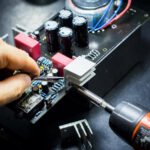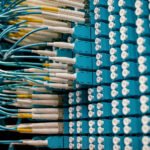The CPU processes the data it receives as input. The CPU receives the data in the form of binary bits, which it can understand. The CPU performs many functions like:
- The CPU can perform arithmetic calculations such as addition, subtraction etc.
- The CPU can perform logical decisions.
- The CPU with the help of other devices can perform data transmission.
- After performing the required task the CPU may place result in memory or send results to the output device according to the instruction givens to it.
- The CPU with the help of its control unit generates timing signals which provide synchronization between the different devices and the CPU.
Also Read:
- Computer Architecture G.K. Multiple Choice Questions With Answers – Part 1
- Computer Architecture G.K. Multiple Choice Questions With Answers – Part 2
Below is the list of Computer Architecture related G.K. Questions:
51. Where does a computer add and compare data ?
- Hard disk
- Floppy disk
- CPU chip
- Memory chip
Correct Answer: C
52. Processors of all computers, whether micro, mini or mainframe must have
- ALU
- Primary storage
- Control unit
- All of the above
Correct Answer: D
53. The basic components of a modern digital computer are :
- Input device
- Output device
- Central processor
- All of the above
Correct Answer: D
54. Which kind of devices allows the user to add components and capabilities to a computer system ?
- System boards
- Storage devices
- Input devices
- Output devices
Correct Answer: D
55. Group of instruction that directs a computer is called
- Storage
- Memory
- Logic
- Program
Correct Answer: D
56. The ascending order of a data hierarchy is
- Bit – bytes – field – record – file – database
- Bit – bytes – record – field – file – database
- Bytes – bit – field – record – file – database
- Bytes – bit – record – field – file – database
Correct Answer: A
57. Microprocessor is a device which has at least
- Memory
- I/O devices
- Registers
- CPU
Correct Answer: D
58. Which of the following registers is loaded with the contents of the memory location pointed by the PC ?
- Memory Address Registers
- Memory Data Register
- Instruction Register
- Program Counter
Correct Answer: C
59. Which is the most powerful type of computers ?
- Micro computer
- Mini computer
- Mainframe computer
- Super computer
Correct Answer: D
60. What is the correct definition of the term ‘instruction set’?
- The range of opcodes which a CPU is programmed to recognize
- The list of instructions in memory which forms the program being executed
- A specific subroutine of a program, run if conditions relating to the flag register are satisfied
- The process by which a single instruction of a program is executed
Correct Answer: A
61. The maximum stages in pipelining architecture are
- 4
- 2
- 6
- 3
Correct Answer: C
62. A multiprocessor computer is of the type
- SISD
- SIMD
- MIMD
- All of the above
Correct Answer: C
63. What is the control unit’s function in the CPU ?
- To transfer data to primary storage
- To storage program instructions
- To perform logic operations
- To decode program instructions
Correct Answer: D
64. How many address lines are needed to address each memory location in a 2048 x 4 memory each
- 10
- 11
- 8
- 12
Correct Answer: B
65. The unit of a computer system that executes program, communicates with and often controls the operation of other subsystems of the computer is known as
- CPU
- Control Unit
- I/O unit
- Peripheral unit
Correct Answer: A
66. Which type of computers use the 8 bit code called EBCDIC ?
- Minicomputers
- Microcomputers
- Mainframe
- Supercomputers
Correct Answer: C
67. The ALU of a computer responds to the commands coming from
- primary memory
- control section
- external memory
- cache memory
Correct Answer: B
68. What happens when you boot up a PC ?
- Portions of the operation system are copied from disk into memory
- Portions of the operating system are copied from memory onto disk
- Portions of the opening system are compiled
- Portions of the operating system are emulated
Correct Answer: A
69. A complete microcomputer system consists of
- microprocessor
- memory
- peripheral equipment
- all of the above
Correct Answer: D
70. Which kind of storage device can be carried around ?
- Floppy disk
- Hard disk
- System cabinet
- Hard disk drive
Correct Answer: A
71. A logic circuit which is used to change a BCD number into an equivalent decimal number is
- decoder
- encoder
- multiplexer
- code converter
Correct Answer: A
72. A shift resister can be used for :
- parallel to serial conversion
- serial to parallel conversion
- digital delay line
- all of the above
Correct Answer: D
73. Memory access in RISC architecture is limited to instructions :
- CALL & RET
- PUSH & POP
- STA & LDA
- MOV & JMP
Correct Answer: C
74. The width of the address bus determines :
- the speed at which information is dealt with
- the amount of instructions the CPU can deal with at one time
- the distance information can be transported in the computer without degrading
- the maximum addressing capacity
Correct Answer: D
75. Interrupts which are initiated by an instruction are
- Internal
- External
- Hardware
- Software
Correct Answer: D
76. Super computers are primarily useful for
- Input-output intensive processing
- Data-retrieval operations
- Mathematical-intensive scientific applications
- All of the above
Correct Answer: C
77. Which is not an input device ?
- CRT (Cathode Ray Tube)
- Optical scanners
- Voice recognition
- COM (Computer Output Microfilm)
Correct Answer: D
78. The Central Processing Unit (CPU) consists of :
- Input, output and processing
- Control unit, primary storage, and secondary storage
- Control unit, arithmetic-logic unit, and primary storage
- Control unit, processing, primary storage
Correct Answer: C
79. The branch logic that provides decision making capabilities in the control unit is known as
- Controlled transfer
- Conditional transfer
- Unconditional transfer
- None of the above
Correct Answer: C
80. In which addressing mode, the effective address of the operand is generated by adding a constant value to the contents of a register ?
- Absolute mode
- Indirect mode
- Immediate mode
- Index mode
Correct Answer: D
81. Systems do not have parallel processing capabilities are
- SISD
- SIMD
- MIMD
- All of the above
Correct Answer: A
82. The next address generator is sometime called a/an
- Instruction sequence
- Program sequence
- Microprogram sequence
- Translator
Correct Answer: C
83. Instruction pipelining has minimum stages :
- 4
- 2
- 6
- 3
Correct Answer: B
84. When the RET instruction at the end of a subroutine is executed:
- the information where the stack is initialized is transferred to the stack pointer
- The memory address of the RET instruction is transferred to the program counter
- Two data bytes stored in the top two locations of the stack are transferred to the program counter
- Two data bytes stored in the top two locations of the stack are transferred to the stack pointer
Correct Answer: C
85. The word size of a microprocessor refers to :
- the amount of a information that can be stored in a byte
- the amount of a information that can be stored in a cycle
- the number of machine operations performed in a second
- the maximum length of an English word that can be input to a computer
Correct Answer: B
86. Who coordinates the sequencing of events within the central processor of a computer ?
- Logic unit
- Arithmetic unit
- Register
- Control unit
Correct Answer: D
87. A microprocessor consists of
- General purpose register
- Program counter
- ALU
- Control unit
Correct Answer: C
88. A control unit whose binary control variables are stored in memory is known as
- Hardwired control unit
- Microprogrammed control unit
- Software control unit
- Hardware control unit
Correct Answer: B
89. part of the computer where data and instructions are held is
- Register unit
- Accumulator
- Memory unit
- CPU
Correct Answer: C
90. What is the correct definition of the term ‘SIMD’ ?
- Single Input, Multiple Destinations
- Single Integration, Multiple Dynamics
- Single Instruction, Multiple Data
- Single Interrupt, Multiple Distribution
Correct Answer: C
91. Data going into the computer is called :
- Output
- Algorithm
- Input
- Calculations
Correct Answer: C
92. Transformation of input into output is performed by____________.
- Peripherals
- Memory
- Storage
- The CPU
Correct Answer: D
93. A_____________is an electronic device that processes data, converting it into information :
- Processor
- Computer
- Case
- Stylus
Correct Answer: B
94. Codes consisting of bars or lines of varying widths or lengths that are computer-readable are known as :
- An ASCII code
- A magnetic tape
- An OCR scanner
- A bar code
Correct Answer: D
95. When you quickly press and release the left mouse button twice you are___________.
- Primary-clicking
- Pointing
- Double- clicking
- Secondary clicking
Correct Answer: C
96. The________key and the____________key can be used in the combination with other keys to perform shortcuts and special tasks :
- Control, ALT
- Function, toggle
- Delete, insert
- Caps lock, Num lock
Correct Answer: A
97. What is the full form of USB as used in computer related activities ?
- Universal Security Block
- Ultra Serial Block
- United Service Block
- Universal Serial Bus
Correct Answer: D
98. To make a notebook act as a desktop model, the notebook can be connected to a… which is connected to a monitor and other devices.
- Bay
- Docking station
- Port
- None of the above
Correct Answer: B
99. _____________Keyboards are more compact and generally have fewer keys :
- Laptop
- Windows
- Macintosh
- QWERTY
Correct Answer: A
100. A_______________allows you to capture sound waves and transfer them to digital format of your computer :
- Speaker
- Microphone
- Keyboard
- Stylus
Correct Answer: B



